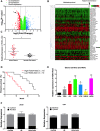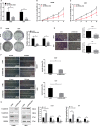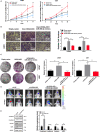LncRNA HOXA-AS3 promotes the malignancy of glioblastoma through regulating miR-455-5p/USP3 axis
- PMID: 32918360
- PMCID: PMC7579690
- DOI: 10.1111/jcmm.15788
LncRNA HOXA-AS3 promotes the malignancy of glioblastoma through regulating miR-455-5p/USP3 axis
Abstract
Our objective was to determine the molecular mechanisms by which lncRNA HOXA-AS3 regulates the biological behaviour of glioblastoma multiforme (GBM). We used an lncRNA microarray assay to identify GBM-related lncRNA expression profiles. Qrt-PCR was used to survey the levels of expression of long non-coding RNA (lncRNA) HOXA-AS3 and the target gene. Dual-luciferase reporter assays were used to investigate the interaction of lncRNA HOXA-AS3, the target gene and miRNA. Western blot analysis was used to examine the expression of USP3 and epithelial-mesenchymal transition (EMT) genes. The MTT assay, transwell assay and wound healing assay were used to analyse the effects of lncRNA HOXA-AS3 on GBM cell viability, mobility and invasiveness, respectively. Our results showed that lncRNA HOXA-AS3 was significantly up-regulated in GBM cells and could promote GBM cell proliferation, invasion and migration in vitro and in vivo. HOXA-AS was found to be associated with poor survival prognosis in glioma patients. The dual-luciferase reporter assay also revealed that lncRNA HOXA-AS3 acts as a mir-455-5p sponge by up-regulating USP3 expression to promote GBM progression. Western blot analysis showed that lncRNA HOXA-AS3 could up-regulate EMT-related gene expression in GBM. Experiments showed mir-455-5p could rescue the effect of lncRNA HOXA-AS3 on cell proliferation and invasion. The newly identified HOXA-AS3/mir-455-5p/USP3 pathway offers important clues to understanding the key mechanisms underlying the action of lncRNA HOXA-AS3 in glioblastoma.
Keywords: USP3; competing endogenous RNA; glioblastoma; lncRNA HOXA-AS3; miR-455-5p.
© 2020 The Authors. Journal of Cellular and Molecular Medicine published by Foundation for Cellular and Molecular Medicine and John Wiley & Sons Ltd.
Conflict of interest statement
The authors confirm that there are no conflicts of interest.
Figures






Similar articles
-
Long non-coding RNA (lncRNA) HOXD-AS2 promotes glioblastoma cell proliferation, migration and invasion by regulating the miR-3681-5p/MALT1 signaling pathway.Bioengineered. 2021 Dec;12(2):9113-9127. doi: 10.1080/21655979.2021.1977104. Bioengineered. 2021. PMID: 34802389 Free PMC article.
-
LINC00511 contributes to glioblastoma tumorigenesis and epithelial-mesenchymal transition via LINC00511/miR-524-5p/YB1/ZEB1 positive feedback loop.J Cell Mol Med. 2020 Jan;24(2):1474-1487. doi: 10.1111/jcmm.14829. Epub 2019 Dec 19. J Cell Mol Med. 2020. PMID: 31856394 Free PMC article.
-
LncRNA MIR4435-2HG potentiates the proliferation and invasion of glioblastoma cells via modulating miR-1224-5p/TGFBR2 axis.J Cell Mol Med. 2020 Jun;24(11):6362-6372. doi: 10.1111/jcmm.15280. Epub 2020 Apr 22. J Cell Mol Med. 2020. PMID: 32319715 Free PMC article.
-
Tumour-regulatory role of long non-coding RNA HOXA-AS3.Prog Biophys Mol Biol. 2024 Jul;189:13-25. doi: 10.1016/j.pbiomolbio.2024.04.003. Epub 2024 Apr 7. Prog Biophys Mol Biol. 2024. PMID: 38593905 Review.
-
The integrated comprehension of lncRNA HOXA-AS3 implication on human diseases.Clin Transl Oncol. 2022 Dec;24(12):2342-2350. doi: 10.1007/s12094-022-02920-w. Epub 2022 Aug 20. Clin Transl Oncol. 2022. PMID: 35986859 Free PMC article. Review.
Cited by
-
LncRNA HOXA-AS3 Promotes the Progression of Pulmonary Arterial Hypertension through Mediation of miR-675-3p/PDE5A Axis.Biochem Genet. 2021 Oct;59(5):1158-1172. doi: 10.1007/s10528-021-10053-y. Epub 2021 Mar 9. Biochem Genet. 2021. PMID: 33687636
-
Engineered Extracellular Vesicles for Drug Delivery in Therapy of Stroke.Pharmaceutics. 2023 Aug 22;15(9):2173. doi: 10.3390/pharmaceutics15092173. Pharmaceutics. 2023. PMID: 37765144 Free PMC article. Review.
-
The Characterization and Differential Analysis of m6A Methylation in Hycole Rabbit Muscle and Adipose Tissue and Prediction of Regulatory Mechanism about Intramuscular Fat.Animals (Basel). 2023 Jan 28;13(3):446. doi: 10.3390/ani13030446. Animals (Basel). 2023. PMID: 36766336 Free PMC article.
-
USP3 promotes gastric cancer progression and metastasis by deubiquitination-dependent COL9A3/COL6A5 stabilisation.Cell Death Dis. 2021 Dec 20;13(1):10. doi: 10.1038/s41419-021-04460-7. Cell Death Dis. 2021. PMID: 34930901 Free PMC article.
-
Overcoming temozolomide resistance in glioma: recent advances and mechanistic insights.Acta Neuropathol Commun. 2025 Jun 5;13(1):126. doi: 10.1186/s40478-025-02046-4. Acta Neuropathol Commun. 2025. PMID: 40468460 Free PMC article. Review.
References
-
- Tian Y, Zheng Y, Dong X. AGAP2‐AS1 serves as an oncogenic lncRNA and prognostic biomarker in glioblastoma multiforme. J Cell Biochem. 2019;120(6):9056‐9062. - PubMed
Publication types
MeSH terms
Substances
LinkOut - more resources
Full Text Sources
Medical
Research Materials

